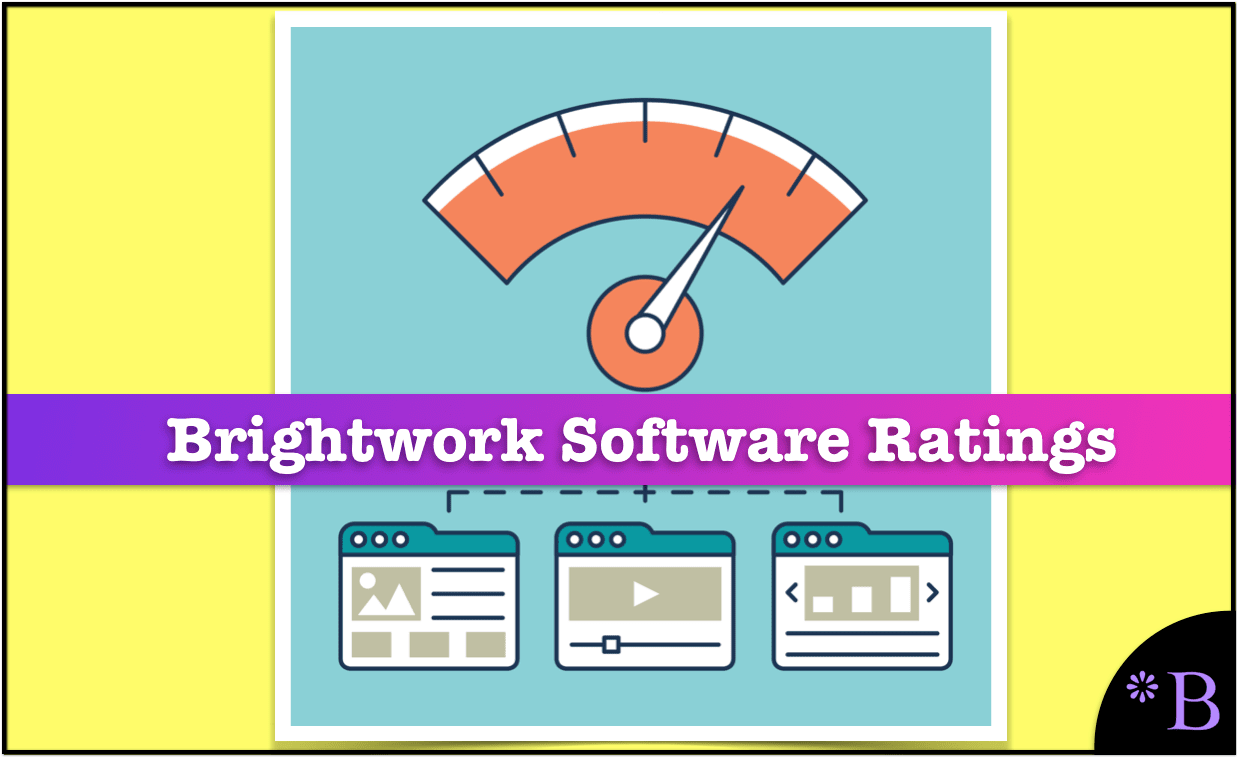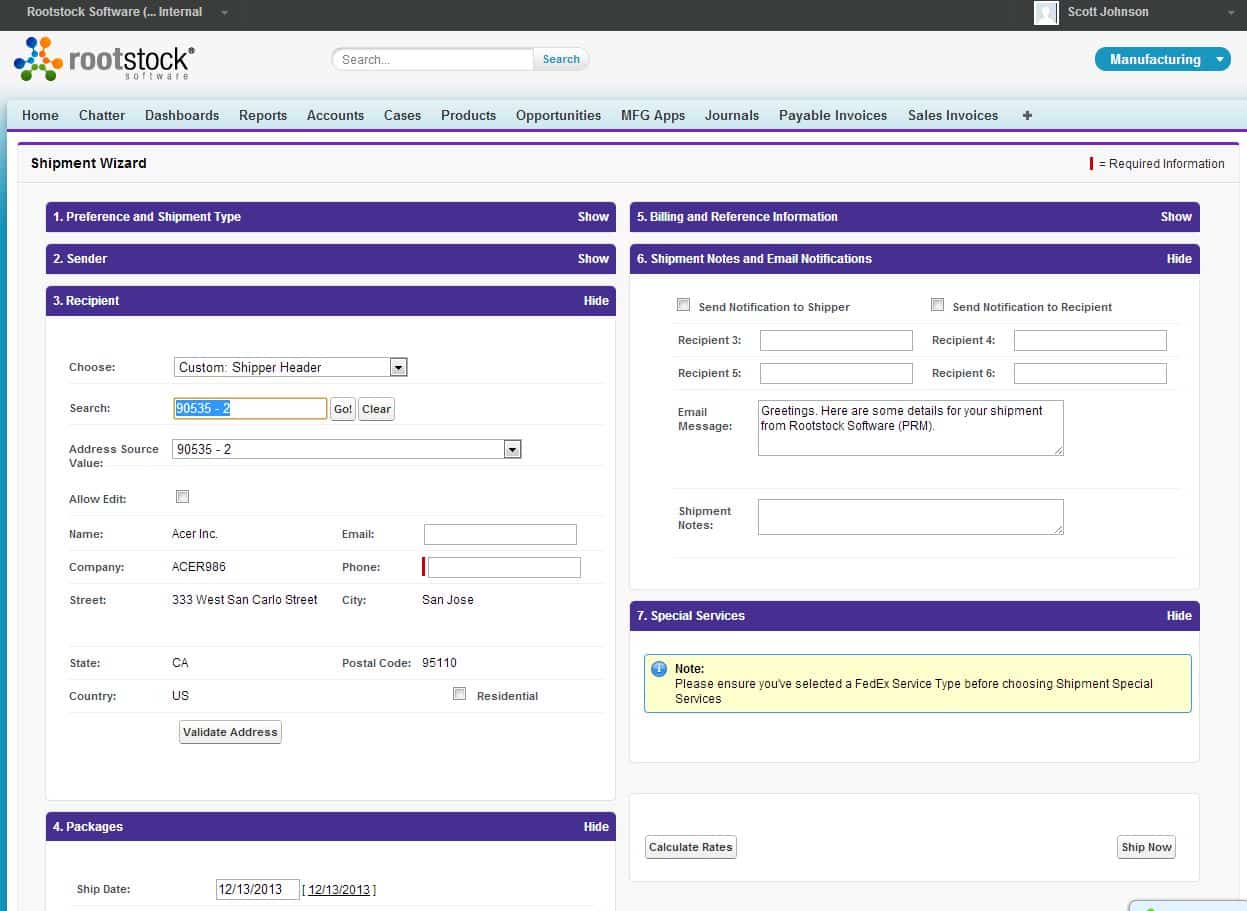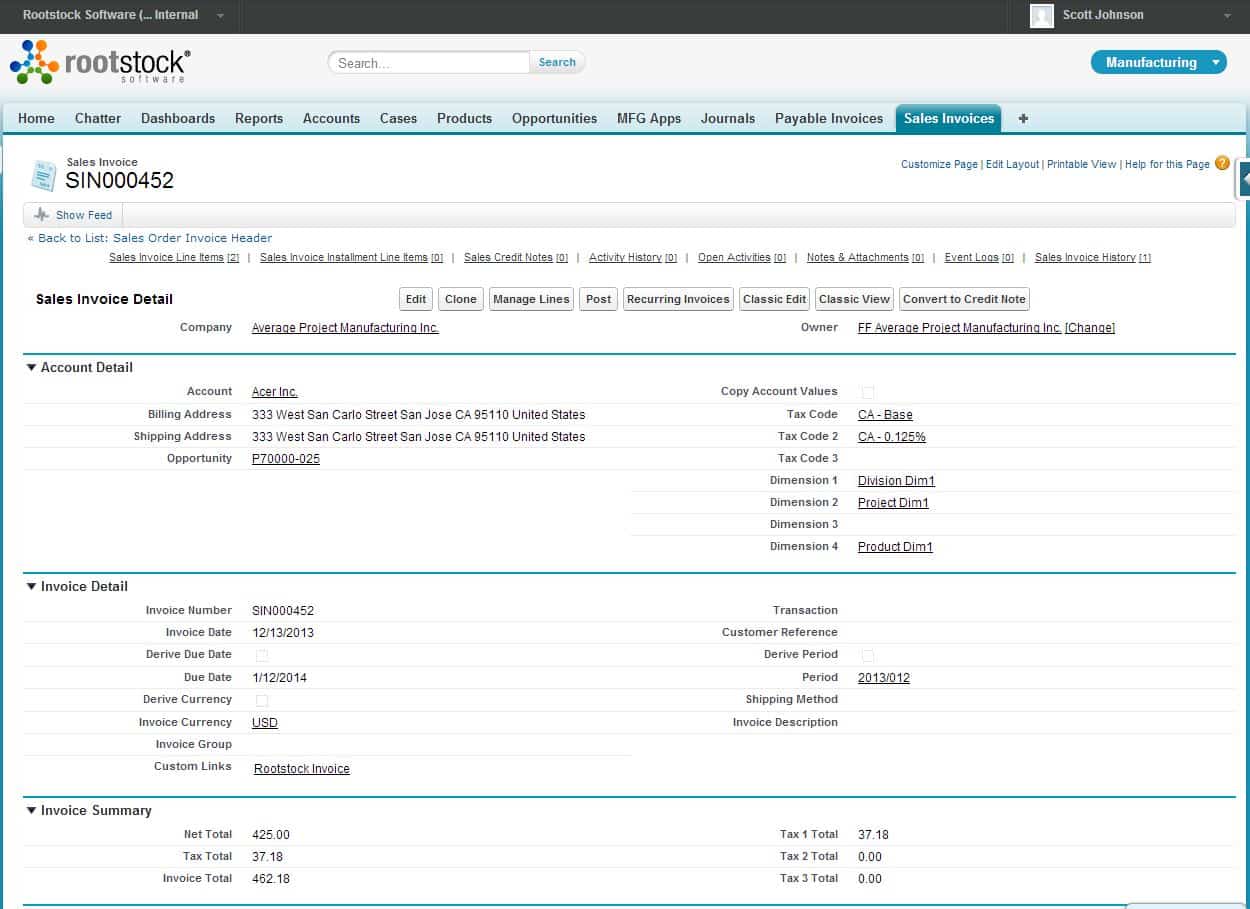Executive Summary
- This is the Brightwork Research & Analysis software rating series.
- We rate both the software and estimate the risk of implementing each application.
MUFI Rating & Risk for Rootstock
MUFI: Maintainability, Usability, Functionality, Implement ability Vendor: Rootstock (Select For Vendor Profile)
Introduction
Rootstock is an extremely young company, started up in only 2008. Considering the size of Rootstock, its application accomplishments are quite impressive – and indicate high developer productivity. Rootstock has one of the greatest potentials to grow of any ERP software vendor that we cover.
Application Detail
Rootstock is part of the Force.com platform, and this means that it inherits all of the platform’s capabilities, including functionalities such as chatter. This is a way for internal parties to stay up to date on objects, as well as allowing external parties such as suppliers to comment. Rootstock can also very easily connect to other Force.com applications, with the ability of a company to bring up Rootstock, FinancialForce (the two combined make up one complete ERP system) as well as other applications such as a FexEx shipping application. This is shown in the screenshot below.
This ease of setup and quality functionality is why Rootstock is our recommended ERP system for mid-sized companies and down – that do not work in process industry manufacturing. Rootstock presents a similar question to companies as Process Pro in that it is one of the few ERP systems to have a competent production planning and scheduling system. As with Rootstock, for companies with more simple production planning and scheduling problems, Rootstock’s functionality could be used instead of purchasing a separate advanced planning product. Rootstock is a good option for buyers that are serious about manufacturing efficiency. This is because many ERP vendors say that they can perform production scheduling when in truth they provide functionality just good enough to impress executives during the sales process, but not good enough to use. In fact, of all of the ERP systems that we cover, only Process Pro and Rootstock meet our standard in terms of having basic functionality for production planning and scheduling. Most of the ERP applications work off of simple MRP for production planning and scheduling combined with a simplified scheduling screen which is underpowered to perform the type of planning and scheduling that manufacturing companies need. However, MRP is only designed to create the initial production plan, and at the very least production planning and scheduling software should have heuristics. (for instance, Rootstock has a scheduling algorithm). This is described in the quotation from Roostock below:
“The first step in the scheduling algorithm is to establish the first work order’s operation’s schedule start date. If the work order has as not yet been started and the Work Order Production Release Dates is later than today’s date, the first operation’s scheduled start date is the Work Order Production Release Date. If the Work Order Production Release Date is less than (or equal to) today’s date, then the first work order’s operation schedule start date is set to today’s date. If the work order has been started, then the first work order operation’s scheduled start date, not as yet completed, will be set to today’s date.”
We will now check the invoice for this shipment, which again will be “within” Rootstock, but which will punch out to FinancialForce.
With the SalesForce platform, each application has to be configured to work as desired, but the customer does not need to spend time, money and effort to integrate the applications. Just this basic connection to the FedEx application would be, in the on-premises ERP world, a big accomplishment. First, the ERP vendor would try to convince their customer to use their dated shipping application (sometimes this functionality is part of the ERP system, but sometimes it is part of another non-ERP product that the ERP vendor is selling). Then the vendor would grudgingly allow the external shipping application provider to connect to their system. Several months later the systems would be integrated—all on the ERP software vendor’s terms of course.
The SalesForce platform is not like that at all; it offers a far more efficient model. The platform provides pre-integration without anyone application ruling the roost and declaring itself the center of the universe. In the future, these integrations will be prebuilt by the software vendors and companies will be able to pick and choose (mix and match) the functionalities that they like. In this environment, it will be difficult for ERP vendors to lock their customers into mediocre functionality. This is the entire business model of the Tier 1 ERP vendors. Rootstock has a very positive upside for companies looking for good value, a fast implementation timeline, and integration to some best of breed applications on the Force.com platform.
MUFI Scores
All scores out of a possible 10.
MUFI Scores
- Ma. = Maintainability
- Us. = Usability
- Fu. = Functionality
- Im. = Implementability
| App | Ma. | Us. | Ft. | Im. | Cat. |
|---|---|---|---|---|---|
| Average Score for Big ERP | 5.1 | 4.8 | 5.2 | 5.4 | Big ERP |
| Average Score for CRM | 6.2 | 6.2 | 5.1 | 5.9 | CRM |
| Average Score for Small and Medium ERP | 8.3 | 8 | 6.7 | 8.5 | Small and Medium ERP |
| Average Score for Finance | 8.8 | 8.8 | 8 | 8.8 | Finance |
| Average Score for Demand Planning | 7.6 | 7.2 | 7 | 7.1 | Demand Planning |
| Average Score for Supply Planning | 6.7 | 6.9 | 7 | 6.8 | Supply Planning |
| Average Score for Production Planning | 6.8 | 6.9 | 7 | 6.9 | Production Planning |
| Average Score for BI Heavy | 5.5 | 5.3 | 6.9 | 5.3 | BI Heavy |
| Average Score for PLM | 7 | 7.2 | 6.8 | 7.3 | PLM |
| Average Score for BI Light | 7.7 | 8.7 | 9 | 8.3 | BI Light |
| Arena Solutions Arena PLM | 10 | 10 | 10 | 10 | PLM |
| AspenTech AspenOne | 4 | 8 | 10 | 7 | Production Planning |
| Birst | 8 | 8.5 | 10 | 8 | BI Light |
| ERPNext | 10 | 10 | 7.5 | 10 | Small and Medium ERP |
| Delfoi Planner | 8 | 6 | 6.5 | 7 | Production Planning |
| Demand Works Smoothie SP | 9 | 10 | 7 | 10 | Supply Planning |
| Hamilton Grant RM | 10 | 9 | 8.5 | 9 | PLM |
| IBM Cognos | 2.7 | 3 | 1.5 | 3 | BI Heavy |
| Infor Epiphany | 7 | 8 | 6 | 5 | CRM |
| Infor Lawson | 8 | 7 | 6 | 7 | Big ERP |
| Intuit QuickBooks Enterprise Solutions | 9 | 9 | 5 | 9 | Finance |
| JDA DM | 9 | 7.5 | 8 | 8 | Demand Planning |
| Microsoft Dynamics CRM | 2 | 3 | 2 | 2 | CRM |
| NetSuite CRM | 6 | 4 | 3 | 3 | CRM |
| Netsuite OneWorld | 7 | 7 | 8 | 8 | Big ERP |
| OpenERP | 7 | 8 | 8.5 | 8 | 7 |
| Oracle BI | 4 | 4 | 3 | 6 | BI Heavy |
| Oracle CRM On Demand | 4 | 5 | 3 | 5 | CRM |
| Oracle Demantra | 5 | 3 | 3.5 | 4.5 | Demand Planning |
| Oracle JD Edwards World | 4 | 1 | 3 | 6 | Big ERP |
| Oracle RightNow | 6 | 7 | 4 | 5 | CRM |
| PlanetTogether Galaxy APS | 10 | 10 | 10 | 10 | Production Planning |
| Preactor | 8 | 7 | 3 | 7 | Production Planning |
| QlikTech QlikView | 9 | 9 | 10 | 9 | BI Light |
| Rootstock | 9 | 8 | 9 | 9 | Small and Medium ERP |
| Sage X3 | 8 | 8 | 7 | 8 | Big ERP |
| Salesforce Enterprise | 8 | 8.5 | 9 | 7.5 | CRM |
| SAP APO DP | 3 | 4 | 3 | 2 | Demand Planning |
| SAP APO PP/DS | 2 | 2 | 4 | 3 | Production Planning |
| SAP APO SNP | 3 | 4 | 8 | 4 | Supply Planning |
| SAP BI/BW | 1.5 | 2 | 4 | 2 | BI Heavy |
| SAP Business Objects | 3 | 2.5 | 7 | 3 | BI Heavy |
| SAP CRM | 4 | 3 | 6 | 4 | CRM |
| SAP ECC | 3 | 3 | 6.5 | 3 | Big ERP |
| SAP PLM | 1 | 2.5 | 2 | 3 | PLM |
| SAP SmartOps | 4 | 4 | 7 | 5.5 | Supply Planning |
| SAS BI | 6.5 | 7 | 9 | 6 | BI Heavy |
| SAS Demand Driven Forecasting | 7 | 8 | 9 | 7 | Demand Planning |
| Tableau (BI) | 9 | 10 | 10 | 10 | BI Light |
| Tableau (Forecasting) | 10 | 8 | 5 | 9 | Demand Planning |
| Teradata | 8 | 6.3 | 9.7 | 6 | BI Heavy |
| ToolsGroup SO99 (Forecasting) | 7 | 8 | 9 | 7 | Demand Planning |
| ToolsGroup SO99 (Supply) | 5 | 6 | 10 | 7 | Supply Planning |
Vendor and Application Risk
Rootstock is one of the simpler ERP systems to implement. First off, the application is not only SaaS-based but is part of the Salesforce platform, which means it can be co-implemented along with other applications that are truly pre-integrated to one another. All that is necessary is to make the configurations of the other applications selected on Salesforce compatible with one another – there is no actual integration as long as the other application is native to the Salesforce platform. Aside from this feature, Rootstock scores very well in implementability, as well as implementation speed.
Likelihood of Implementation Success
This accounts for both the application and vendor-specific risk. In our formula, the total implementation risk is application + vendor + buyer risk. The buyer specific risk could increase or decrease this overall likelihood and adjust the values that you see below.
Likelihood of Application Implementation Success and Failure
Search for the application in this table using the search bar in the upper right of the table.
| Application | Prob of Implementation Success | Prob of Implementation Failure |
|---|---|---|
| Actuate | 0.77 | 0.23 |
| SAP Smartops | 0.39 | 0.61 |
| NetSuite CRM | 0.46 | 0.54 |
| Sugar CRM | 0.62 | 0.48 |
| Base CRM | 0.91 | 0.09 |
| SAP CRM | 0.35 | 0.65 |
| Salesforce Enterprise | 0.72 | 0.28 |
| QlikTech QlikView | 0.82 | 0.18 |
| Tableau (BI) | 0.98 | 0.02 |
| SAP Crystal Reports | 0.46 | 0.54 |
| Brist | 0.83 | 0.17 |
| MicroStrategy | 0.7 | 0.3 |
| SAS BI | 0.76 | 0.24 |
| Oracle BI | 0.35 | 0.65 |
| IBM Cognos | 0.23 | 0.77 |
| Infor Epiphany | 0.58 | 0.42 |
| Microsoft Dynamics CRM | 0.26 | 0.74 |
| Oracle RightNow CRM | 0.41 | 0.59 |
| Oracle CRM On Demand | 0.36 | 0.64 |
| Teradata | 0.76 | 0.24 |
| SAP Business Objects | 0.32 | 0.68 |
| SAP BI/BW | 0.25 | 0.75 |
| SAP PLM | 0.29 | 0.71 |
| Hamilton Grant RM | 0.89 | 0.11 |
| Arena Solutions | 0.96 | 0.04 |
| Delfoi Planner | 0.7 | 0.3 |
| Preactor | 0.64 | 0.36 |
| PlanetTogether Galaxy APS | 0.96 | 0.04 |
| AspenTech AspenOne | 0.55 | 0.45 |
| SAP APO PP/DS | 0.27 | 0.73 |
| Demand Works Smoothie SP | 0.93 | 0.07 |
| ToolsGroup SO99 (Supply) | 0.82 | 0.18 |
| Demand Works Smoothie | 0.96 | 0.04 |
| Tableau (Forecasting) | 0.9 | 0.1 |
| SAS Demand Driven Forecasting | 0.82 | 0.18 |
| ToolsGroup SO99 (Forecasting) | 0.86 | 0.14 |
| JDA DM | 0.57 | 0.43 |
| Oracle Demantra | 0.33 | 0.67 |
| SAP APO DP | 0.28 | 0.72 |
| FinancialForce | 0.92 | 0.08 |
| Intacct | 0.98 | 0.02 |
| Intuit QB Enterprise | 0.8 | 0.2 |
| ERPNext | 0.9 | 0.1 |
| OpenERP | 0.78 | 0.22 |
| Rootstock | 0.91 | 0.09 |
| ProcessPro | 0.93 | 0.07 |
| Microsoft Dynamics AX | 0.4 | 0.6 |
| SAP Business One | 0.49 | 0.51 |
| Sage X3 | 0.62 | 0.38 |
| Infor Lawson | 0.58 | 0.42 |
| Epicor ERP | 0.4 | 0.6 |
| Oracle JD Edwards World | 0.31 | 0.69 |
| Oracle JD Edwards EnterpriseOne | 0.36 | 0.64 |
| SAP ERP ECC/R/3 | 0.32 | 0.68 |
| NetSuite OneWorld | 0.65 | 0.35 |
Risk Definition
See this link for more on our categorizations of risk. We also offer a Buyer Specific Risk Estimation as a service for those that want a comprehensive analysis.
Risk Management Approach
There are no special preparations that are required for a Rootstock implementation regarding risk management.
Finished With Your Analysis?
To go back to the Software Selection Package page for the Small and Medium ERP software category. Or go to this link to see other analytical products for Rootstock.
References
https://www.rootstock.com/cloud-scheduling-capacity-planning/


